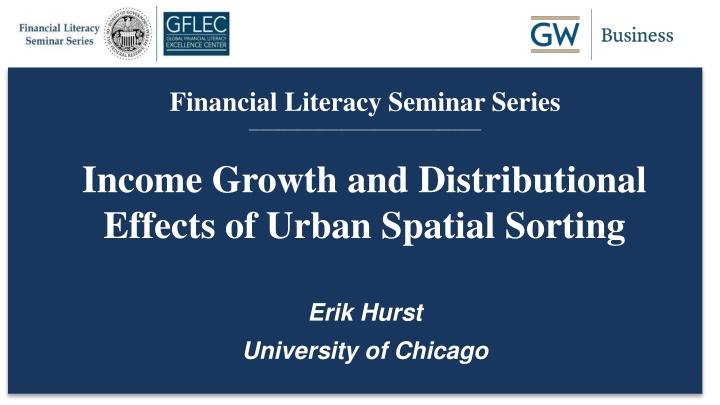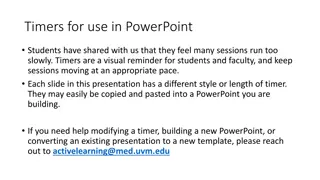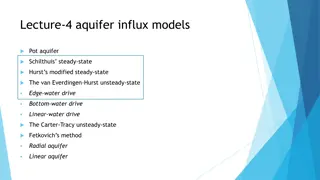
Income Growth and Urban Spatial Sorting Effects - Seminar Series Insights
Explore the income growth and distributional effects of urban spatial sorting in the U.S., including factors influencing neighborhood change and gentrification. Discover how top income growth impacts urban centers and learn about the propensity to live downtown based on income brackets. Gain valuable insights from seminars by experts like Erik Hurst and Victor Couture to understand the evolving urban landscape.
Uploaded on | 2 Views
Download Presentation

Please find below an Image/Link to download the presentation.
The content on the website is provided AS IS for your information and personal use only. It may not be sold, licensed, or shared on other websites without obtaining consent from the author. If you encounter any issues during the download, it is possible that the publisher has removed the file from their server.
You are allowed to download the files provided on this website for personal or commercial use, subject to the condition that they are used lawfully. All files are the property of their respective owners.
The content on the website is provided AS IS for your information and personal use only. It may not be sold, licensed, or shared on other websites without obtaining consent from the author.
E N D
Presentation Transcript
Financial Literacy Seminar Series _______________________________________ Income Growth and Distributional Effects of Urban Spatial Sorting Erik Hurst University of Chicago
Income Growth and the Distributional Effects of Urban Spatial Sorting Victor Couture, Cecile Gaubert, Jessie Handbury and ErikHurst April 2019
Three Motivating Facts The last few decades in the U.S. have seen: Sharp growth in income inequality, driven by the top Higher income individuals moving towards urban centers Renewed discussion of neighborhood change within urban areas Anti-gentrification protests in SF, Chicago, Portland, Atlanta NYC: new zoning policies to slow down gentrification
Three Motivating Facts The last few decades in the U.S. have seen: Sharp growth in income inequality, driven by the top Higher income individuals moving towards urban centers Renewed discussion of neighborhood change within urban areas Anti-gentrification protests in SF, Chicago, Portland, Atlanta NYC: new zoning policies to slow down gentrification This paper: How much does the increasing incomes of the rich contribute to neighborhood change? Develop novel mechanism linking top income growth, spatial sorting, and neighborhood change.
Propensity to Live Downtown is U-Shaped in Income Share of Income Bracket in Urban Tracts 2.5 Census data 2 Top 100 CBSA Family income Constant 1999 dollars (Normalized*) 1.5 Downtown = constantgeography 1 Tracts closest to center = 10% of pop. in2000 .5 100000 Median Family Income (1999 US$) 200000 0 300000 1970 1990 *Normalized by aggregate urban share: 0.17 in 1970, 0.10 in 1990, and 0.08 in2014
Propensity to Live Downtown is Increasingly U-Shaped in Income Share of Income Brackets in Urban Tracts 2.5 2 (Normalized*) 1.5 1 .5 0 100000 200000 300000 Median Family Income 1970 1990 2014 Normalized by aggregate urban share: 0.17 in 1970, 0.1 in 1990, and 0.08 in2014
What We Do 1. Develop spatial equilibrium model Goal = Model U-shape in location choice, and its evolution Agents have common non-homothetic preferences, model generatesnon-monotonic sorting patterns Neighborhood change: endogeneous amenities of urbanlocations 2. Quantify model with micro data 3. Study counterfactuals: How much do increasing incomes of the rich contribute to neighborhood change and change in U- shape (within CBSA spatial sorting by income)? Effect on welfareinequality Impact of policies aimed at mitigating neighborhood change
Mechanism: Luxury Amenities + Top Income Growth As individuals at the top of income distribution get richer: Some newly wealthy households move downtown to have better access to luxury urban amenities Housing prices and amenity provision respond endogenously Influx of the rich into urban areas yields pecuniary externalities by driving up housing prices Poor urban incumbents (mostly renters) become worse off: Pay higher rents for amenities they do not value as much if they stay downtown Or migrate out tosuburbs Implication: Growth in income inequality can understate growth in well-being inequality, when spatial sorting responses are ignored.
Preview of Results Between 1990 and 2014, the income gap grew by 22%. 1. Change in income distribution, with resulting neighborhood change, can explain a substantial part of the urbanization of the rich since 1990. 2. Growth in measured income inequality understates growth in welfareinequality. Well-being gap grew by an additional 2p.p., accounting for spatial reponses. Spatial responses are on net welfare-decreasing for lower income renters. 3. Location-based policies can help mitigate neighborhood change and spatial sorting, but impact on well-being gap islimited.
Literature Review Within-City Sorting with Income Heterogeneity: LeRoy and Sonstelie (1983), Brueckner et al. (1999), Glaeser et al. (2008), Gaigne et al. (2017), Fogli and Guerrieri (2018) Cross-City Sorting with Income Heterogeneity: Gyourko et al. 2013 (superstar cities), Moretti 2013 (real wage inequality), Diamond 2016 (endogenous amenities) Quantitative Spatial Models, Trade: Redding and Rossi-Hansberg(2017), Fajgelbaum et al. (2011), Fajgelbaum and Gaubert (2018), Tsivanidis (2018) Consumer Cities: Glaeser et al. 2001 Causes of Neighborhood Change: Rosenthal (2008), Guerrieri et al. (2013), Edlund et al., (2017), Baum-Snow and Hartley (2017), Ellen et al. (2017), Su (2017), Couture and Handbury(2017) Consequences of Neighborhood Change: Lester and Hartley 2014 (jobs); Behrens et al. 2017 (businesses); Meltzer and Ghorbani 2017 (commute time); Autor et al. 2017 (crime); Vigdor et al. 2002, Freeman 2005, McKinnish et al. 2010, Waights 2014, Ding et al. 2016, (displacement); Brummet and Reed 2018; Su 2017
Focus of the paper Our goal is to study the effect of rising income inequality on neighborhoods and (in turn) welfare. This mechanism is not the only explanation for urban gentrification: 1. Demographics and delayed family formation (Couture and Handbury 2017) The U-shape over time is almost identical including controls for family structure and age. * 2. Skilled working longer hours so want shorter commutes (Edlund et al. 2016, Su 2017) Our model has fixed commute costs rising with wage. * Commute time has increased, highest increase for high incomes living downtown * 3. Urban crime drop in 1990s (Ellen et al. 2017) Some may precede, some may be part of amplification mechanism in our model. * The model could be used/extended to study the power of these alternatives.
Roadmap 1 Some MotivatingFacts 2 Spatial Equilibrium Model 3 Quantification 4 Counterfactual Analysis
1 Some MotivatingFacts 2 Spatial Equilibrium Model 3 Quantification 4 Counterfactual Analysis
Data US census (Decennial 1970-2000 + ACS 2012-2016) Combine bracketed tract-level data with PUMA-level micro data All income measures are at the household/family level in 1999 dollars Focus on the 100 CBSAs with the largest populations in 1990 Downtown contains the tracts closest to the city center = 10% of a CBSA s population in 2000. For descriptive work, measure neighborhood change with percent median income growth. Correlated with population, college share, house prices, homeownership rates, and restaurant quality over the same period.
Neighborhood Change is Concentrated in Local Downtown Areas Chicago <0% 0% 20% 20% 40% 40% 50% 50% 60% 60% 100% <0% 0% 20% 20% 40% 40% 50% 50% 60% 60% 100% >100% No data Philadelphia - - Boston NYC
Neighborhood Change is Concentrated in Local Downtown Areas Boston <0% 0% 20% 20% 40% 40% 50% 60% 100% <0% 0% 20% 20% 40% 40% 50% 50% 60% 60% 100% >100% Parks andAirports No data
High Income Growth CBSAs saw More UrbanGentrification .5 Growth From 1990 to 2013 .4 Tracts with 50% Median Income .3 .2 .1 0 0 .1 .2 .3 .2 .1 Change in Log AverageIncome DowntownTracts SuburbanTracts Note: Plot depicts the share of a CBSA s downtown (blue circles) and suburban (yellow triangles) tracts that saw income growth at or above 50% between 1990 and 2013 against the change in that CBSA s log average income.
High Income Growth CBSAs saw More U-ShapeAmplification Note: Plot depicts the increase in the urban share of households earning more than $70,000 between 1990 and 2014 relative to the urban share of all households in a CBSA against the change in that CBSA s log average income.
1 Some MotivatingFacts 2 Spatial Equilibrium Model 3 Quantification 4 Counterfactual Analysis
Notion of Space within Model: An Overview Individuals choose, among other things, a neighborhood where to live indexed by r. Neighborhoods are indexed by area n (downtown vs. suburbs) and quality j (high vs. low). An endogenous amount of neighborhoods r in each (n, j ) pair. Downtown vs suburbs differ in three ways: proximity to jobs, land supply elasticity and endogenous publicly provided amenities (An ) Neighborhood quality (Qj ) is such that QH > QL. Individual also draw idiosyncratic preferences overneighborhoods. Neighborhoods also provide one unit of housing and access to endogenously provided private amenities. Housing and amenity prices are determined in equilibrium via competitive land markets
Household Problem: An Overview A household with labor income w selects a neighborhood r , residential amenities a, and other numeriere consumptionc: ( \ ( \1 a c 1 max Ur( ) = An(r)Qj(r)br( ) r,c,a subjectto h r a r (1 )w( ) T ( )+ ( ) p + P a+ c n(r) where c is homogeneous consumption good; a is consumption of private residential amenities An(r ), Qj(r ), br ( ): intrinsic quality shifters for neighborhood r ph : unit housing rents (varies by neighborhood); Pa : amenity price index (varies by neighborhood) r r n(r ): commute cost; T ( ) - net local taxes/transfers ; ( ) - returns from homeownership (Ignore both for now)
Birds-eye view: Indirect Utility Formulation Make a discrete choice of neighborhood r where to live in the city given disposableincome: max V ( ) = [(1 )w p ] B b ( ) r r r r r r disp. income Housing cost pr , Commuting costs r Endogenous attractiveness/quality Br , Idiosyncratic pref. br( ) Br encompasses An (r ), Qj (r ) and price of neighborhood amenity bundle Complementarity between quantity of consumption (disp. income) and attractiveness of neighborhood Br Sorting of higher incomes in more attractive neighborhoods
Birds-eye view: Neighborhoods (Part 1) max V ( ) = [(1 )w p ]B b ( ) r r r r r r Neighborhoods r = housing units + urban amenities. Vertically differentiated by location n (Downtown/Suburbs) and type j (High /Low): Bnj Within 4 location-type options nj : neighborhoods horizontally differentiated, symmetric: Br = Bnj br ( ): idiosyncratic preference shock for neighborhood r : distributedFrechet Top nest: choice of location-quality option n, j (shape ) * Lower nest: choice of neighborhood r among options in n, j (shape ) * To match U-shape pattern,intuition: Ordering of options: Downtown Low < S L < SH < D H
Birds-eye view: Neighborhoods (Part 2) max V ( ) = [(1 )w p ]B b ( ) r r r r r r Choose a neighborhood characterized by n {D, S} and j {H, L} AnQj Pa nj r( ) max V ( ) = [(1 )w p ] ( r \ b n nj r An {AD , AS }: location-wide public amenity level Qj {QH , QL}: neighborhood type Pa : CES price index, access to urban amenities in other neighborhoods nj
Attractiveness Depends on Endogeneous Private Amenities In location n, private developers build neighborhoods (housing+retail space) of High or Low type Free entry of developers: supply of neighborhoods Nnj responds to demand Households value access to amenities in other neighborhoods (e.g. restaurants) : CES price index for amenities Pnj CESamenities I I n j nj Depends on variety and access: N I I and (representative) distance to them d n j Distance endogenous = related to land area of the location n (data) Households prefer consuming amenities of their own n, j type Love of variety in residential choices: Nnj plays the same role as a quality shifter Comes from Frechet preference over Nnj neighborhoods Frechetdraws High-w moving in D increase supply and attractiveness of DH neighborhoods that high-w value
Attractiveness Depends on Endogeneous Public Amenities Recall: AnQj Pa nj max V ( ) = [(1 )w p ] ( \ b ( ) r n nj r r Local governments invest in public amenities An in theirlocation Collect local taxTn Build non-rival public amenity in location n (schools, parks, fight crime...) An = Ao (Tn) n High incomes moving in D increase amenities in both high and low quality neighborhoods of D
House prices are endogenous: land market response Separate land market in D and S, priced competitively Endogenous allocation to High / Low quality neighborhoods Transmission channel between H and L neighborhoods within locationn High incomes moving in D increase prices in both high and low quality neighborhoods of D Land supply more inelastic downtown Elasticity of land supply En , ES > ED Higher price response in D ; limits in-migration inD Suburbs grows by sprawl, downtown grows by density access to amenities easier in D than S High incomes moving in D (vs S) have stronger feedback effect through amenities
Summary: Location Choice Depends on Income Representative Indirect Utility in n, j 1 N An Qj Pa nj Vnj(w) = ( [(1 n)w pnj] nj ) .; .; disp.income Bnj DowntownqH Indirect utility Vnj Suburbs qH SuburbsqL DowntownqL PDL PSL PSH PDH Incomew
Summary: Location Choice Depends on Income Representative Indirect Utility in n, j Location choice 1 N An Qj Pa nj Vnj(w) = ( VDH DL [(1 n)w pnj] nj ) (w ) + V (w ) n,jV nj (w) (w ) = .; D .; disp.income Bnj DowntownqH Indirect utility Vnj Suburbs qH SuburbsqL DowntownqL PDL PSL PSH PDH Incomew
Location Choice Depends on Income Location choice shaped by V nj (w ) and , shape of Frechet distribution governs top nest between n, j options Notice: ( \ nj(w)/ nj(w ) DL(w)/ DL(w ) (w p ) / (w p ) (w pDL)/ (w pDL) nj nj = Propensity of high vs low income to live in a given area depends on disposable income w pnj governs strength of non-homotheticity High : location choices are strongly income-dependent
Equilibrium An equilibrium of the model is: a distribution of location choice by income n,j (w) a number of neighborhoods of each type Nn,j land, housing and amenity prices suchthat: Households choose their location to maximize utility, and choose consumption (a, c) optimally Developers and landowners maximize profits The markets for land, housing and amenities clear Developers make zero profits Local government budget isbalanced
Key Model Outcomes 1. Share of workers choosing to live downtown depends on income: V DH(w) + V DL(w) D(w) = ) , V (w) n {D,S},j {H,L} nj 2. Welfare measure for income w -workers in equilibrium t: Representative utility at every income level w: function maps income to welfare for equilibrium t: l 1 V (t)(w) V(t)(w) = nj n,j Dollar-term measure: compute Compensating Variation for income percentile i between t = 1990 and t = 2014: CV(i) = e(p2014,V2014(i)) e(p2014,V1990(i))
Distributional effects of a shock In response to a shock (e.g., income distributionchange) Compute new neighborhood amenities, prices, and resulting sorting patterns Compute welfare change for all w (compensating variation) Maps income inequality change to welfare inequality change, accounting for spatial responses
Key Parameters : Rrechet parameter on choice of (n, j ) pairs. Governs strength of non-homotheticity with income. : Frehet parameter on choice of neighborhoods within (n, j ) pairs. Governs strength of love of variety effects. : Cobb-Douglas parameter governing private amenity share. Makes private amenities more important. : Elasticity of substitution of private amenities across neighborhoods. Governs strength of love of density effects. En: Land supply elasticities for downtown and suburbs. Governs house price response. n : Commuting costs for downtown andsuburbs.
1 Some MotivatingFacts 2 Spatial Equilibrium Model 3 Quantification 4 Counterfactual Analysis
Quantification Strategy Stage 1: Quantification of Model Elasticities Estimation of keyelasticities Calibration of otherelasticities Stage 2: Method ofmoments Calibrate remaining parameters to match location choices by income and relative house prices in 1990
From model to data: key parameters that mediate impact of a shock Estimate/ calibrate parameters thatgovern: 1. Costs Housing supply elasticities: * ED = 0.60, ES = 1.33 (Saiz elasticities, low vs high density) Commute cost (income share): D =0.044, S =0.059 (2009 NHTS) 2. Non-homothetic locationchoice next: estimate 3. Endogenous amenitiesresponse: Amenity share: = 0.15 (CEX) Public amenity response: calibrated from literature. ( = 0.05) Access to a variety of amenities and neighborhoods: next
Empirical Notions of Space Neighborhood rnj inCBSA Census tracts within an area-quality tier pair Area n {D, S} withinCBSAs: D = all tracts close to center city of main CBSA containing 10 percent of CBSA population S = all remaining tracts in CBSA Quality j {H, L} measured at the tract-level using: density of high-quality restaurant chains college share 40% (top 20 percent of all tracts in 2000)
Non-homotheticity in location choice is governed by Take estimating equation for model parameter directly from the model: cj ( \ ( \ share of w in Dj share of w inSj + l nBDj w p w pSj Dj ln = ln +Ecjw BSj c c How much more high-w are willing to choose a high quality-high price neighborhood? Threat to identification: Unobserved amenities targeting e.g. richer households could attract them disproportionally IV strategy: Bartik income growth shock, interacted with income bracket dummy
Non-homotheticity in location choice Visualize source of variation: reduced-formregression Location choice on Bartik shock, income bracket by income bracket High-w tend to relocate more to downtown as a response to a city-wide income shock. ( \ share of w in D share of w in S Bartik = + Income + Ecw ln w w c c 20 10 Elasticity 0 10 5000 10000 Median HH Income withinBracket (logscale) 25000 60000 100000 175000 95% CI Coefficient The model parameter identified by the corresponding IV regression.
Non-homotheticity in location choice is governed by Estimating equation for model parameter : ( \ ( \ share of w in D,j share of w inS,j w pDj w pSj ln = ln + + E cj cjw c c Quality Definition: College Share (1) OLS 1.34 (0.09) Quality Definition: Restaurant Chain (3) OLS 1.38 (0.13) (2) IV 3.19 (0.20) (4) IV 3.38 (0.27) Yes Yes Yes Yes cj R2 KP F-Stat Obs 0.84 0.87 45.37 1,599 48.02 1,434 1,599 1,434 Notes: Data from 2000 and 2014 in 100 largest CBSAs. Observations are CBSA-population weighted. Standard errors in parentheses. KP F-Stat = Kleinberger-Papp Wald F statistic.
Parameters that govern amenity consumption Derive gravity regression for trips to amenities from model: r+ rI ( Dummy I \ ( \ ) = ln j(r)j(rI) ln ( \ j(r )I=j(r ) pa pa NTripsrrI NTrips drrI d rI ln + ln . rr rr r Origin and destination fixed effect to control for unobserved quality and price differences Dummy consuming amenities in a neighborhood of different quality than own Data from smartphone geolocations 9.6 billion visits to commercial establishments from 87 million devices Select trips: home non-tradable services (restaurants, gyms, theaters, etc.) * side note: 81% trips are in same quality neighborhood as home
Gravity Parameter for Amenity Demand () ( \ ( \ d drr Trips I Tripsrr I rr rr = j(r )/=j(r ) + E (w ) I + + I ln ln r cj r Quality Definition: College Share (2) Home Quality Definition: Restaurants Chain (6) Home (1) All (3) (5) All (7) (4) (8) Weekend Weekend Home-Home Home-Home -1.57 (0.00) -1.42 (0.00) -1.20 (0.00) -1.18 (0.00) -1.56 (0.00) -1.40 (0.00) -1.18 (0.00) -1.17 (0.00) j(r)I=j(rI) -0.14 (0.00) -0.12 (0.00) -0.10 (0.00) -0.09 (0.00) -0.04 (0.00) -0.03 (0.00) -0.03 (0.00) -0.03 (0.00) R2 Obs 0.91 0.87 0.88 0.85 0.91 0.87 0.88 0.85 22,791,347 6,403,153 11,924,874 3,050,752 19,858,033 5,645,813 10,419,101 2,696,680 Notes: Standard errors are clustered by home tract (r ) and visit tract (rI). Estimate = 1.4 Separate elasticity of substitution from commuting frictions using = 6.5, hence = 0.2
Elasticity of Substitution within Neighborhood Type () Bound estimate of between = 3.3 and = 6.5 Nested structure of model implies: < Research shows that neighborhood segregation is higher than segregation of consumption in residential amenities (like restaurants, groceries, etc.). Implies: > Conservative baseline: = 6.5 (show robustness to other values including = )
The calibrated model replicates initial spatial sorting patterns well Calibrate initial qualities Bn,j and initial prices pn,j to best match: U-shaped distribution of location choices and relative prices in 1990 given distribution of income and elasticities
1 Some MotivatingFacts 2 Spatial Equilibrium Model 3 Quantification 4 Counterfactual Analysis
Shift in income distribution can explain a large share of spatial resorting share living downtown by 1990 income decile Income growth 1990-2014 by 1990 incomedecile Income Growth(%) 25 20 Income Growth (%) 15 10 5 0 -5 1 2 3 4 5 6 7 8 9 10 1990 IncomeDecile Our mechanism is one of several drivers behindurban gentrification Jobs (Edlund et al. 2016, Su 2017), crime drop in 1990s (Ellen et al. 2017) Per cap. income growth: +10% 90-10 income gap increase:+22pp
Mechanisms: price and quality changes Price Change (p n,j ) Quality Change (B n,j ) House Prices ( pnj,t ) (%) B (%) nj,t 8 20 7 15 6 5 10 4 5 3 2 0 1 0 -5 DL DH SL SH DL DH SL SH With income distribution changes, prices rise downtown and low quality neighborhoods gentrify Prevalence of high quality neighborhood increases in D, and their quality increases Low quality neighborhoods barely see a quality change, on net - but there is less of them Price and quality effects disproportionately hurt thepoor.
Urban spatial sorting reinforces welfare inequality CV- Income Income1990 Compute change in welfare (CV) accounting for spatial responses. Plot AllHouseholds RentersOnly 2 2 Income)/Income1990 (%) Income)/Income1990 (%) 1.5 1.5 1 1 0.5 0.5 0 0 -0.5 -0.5 (CV - (CV - -1 -1 1 2 3 4 5 6 7 8 9 10 1990 IncomeDecile 1 2 3 4 5 6 7 8 9 10 1990 IncomeDecile Change in income inequality understates the change in well-being inequality by about 10% Homeowners are better off that renters - as they reap house priceappreciation





















